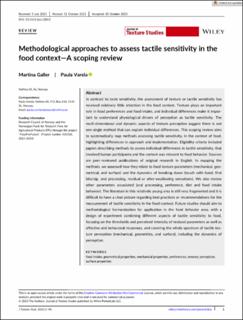| dc.description.abstract | In contrast to taste sensitivity, the assessment of texture or tactile sensitivity has received relatively little attention in the food context. Texture plays an important role in food preferences and food intake, and individual differences make it important to understand physiological drivers of perception as tactile sensitivity. The multi-dimensional and dynamic aspects of texture perception suggest there is not one single method that can explain individual differences. This scoping review aims to systematically map methods assessing tactile sensitivity, in the context of food, highlighting differences in approach and implementation. Eligibility criteria included papers describing methods to assess individual differences in tactile sensitivity, that involved human participants and the context was relevant to food behavior. Sources are peer-reviewed publications of original research in English. In mapping the methods, we assessed how they relate to food texture parameters (mechanical, geometrical, and surface) and the dynamics of breaking down (touch with hand, first bite/sip, oral processing, residual or after-swallowing sensations). We also review other parameters associated (oral processing, preference, diet and food intake behavior). The literature in this relatively young area is still very fragmented and it is difficult to have a clear picture regarding best practices or recommendations for the measurement of tactile sensitivity in the food context. Future studies should aim to methodological harmonization for application in the food behavior area, with a design of experiment combining different aspects of tactile sensitivity to food, focusing on the thresholds and perceived intensity of textural parameters as well as affective and behavioral responses, and covering the whole spectrum of tactile texture perception (mechanical, geometrics, and surface), including the dynamics of perception. | |
